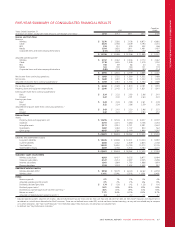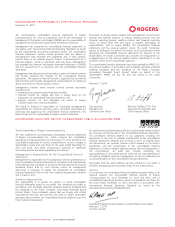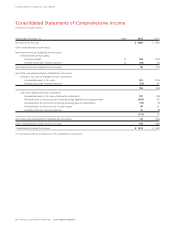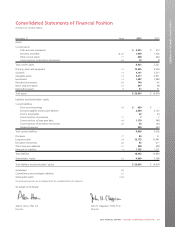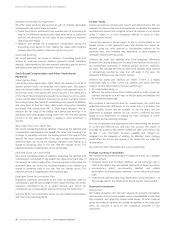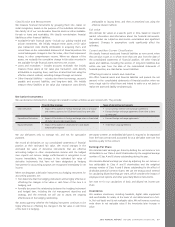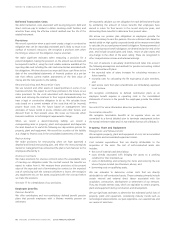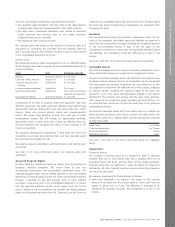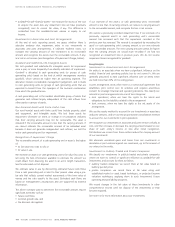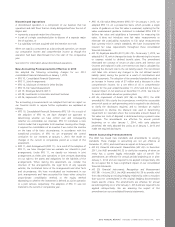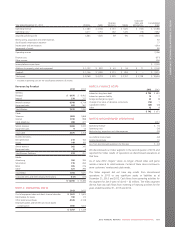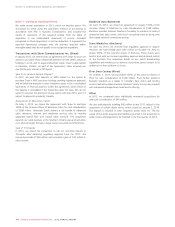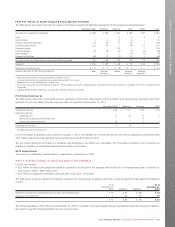Rogers 2013 Annual Report Download - page 101
Download and view the complete annual report
Please find page 101 of the 2013 Rogers annual report below. You can navigate through the pages in the report by either clicking on the pages listed below, or by using the keyword search tool below to find specific information within the annual report.
NOTES TO CONSOLIDATED FINANCIAL STATEMENTS
Classification and Measurement
We measure financial instruments by grouping them into classes on
initial recognition, based on the purpose of the individual instruments.
We classify all of our non-derivative financial assets as either available-
for-sale or loans and receivables. We classify non-derivative financial
liabilities as other financial liabilities.
• Available-for-sale financial assets – include our publicly traded and
private investments. We initially measure these assets at fair value
plus transaction costs directly attributable to acquiring them, and
record them on the consolidated statements of financial position. We
record subsequent changes in their fair value, other than impairment
losses, in other comprehensive income. When we dispose of the
assets, we reclassify the cumulative change in fair value recorded in
the available-for-sale financial assets reserve to net income.
• Loans and receivables – includes accounts receivable. We initially
measure these assets at fair value plus transaction costs directly
attributable to acquiring them, and then at amortized cost using the
effective interest method, recording changes through net income.
• Other financial liabilities – includes short-term borrowings, accounts
payable and accrued liabilities, and long-term debt. We initially
measure these liabilities at fair value plus transaction costs directly
attributable to issuing them, and then at amortized cost using the
effective interest method.
Fair Value
We estimate fair values at a specific point in time, based on relevant
market information and information about the financial instruments.
Our estimates are subjective and involve uncertainties and significant
judgment. Changes in assumptions could significantly affect the
estimates.
Current and Non-Current Classification
We classify financial assets and financial liabilities as non-current when
they are due in part or in whole more than one year from the date of
the consolidated statements of financial position. All other financial
assets and liabilities, including the portion of long-term liabilities due
within one year from the date of the consolidated statements of
financial position, are classified as current liabilities.
Offsetting Financial Assets and Liabilities
We offset financial assets and financial liabilities and present the net
amount in the consolidated statements of financial position when we
have a legal right to offset them and intend to settle on a net basis or
realize the asset and liability simultaneously.
Derivative Instruments
We use derivative instruments to manage risks related to certain activities we are involved with. They include:
The risk they manage Types of derivative instruments
Debt Derivatives • Impact of fluctuations in foreign exchange rates on principal
and interest payments for US denominated long-term debt
• Cross-currency interest rate exchange agreements
• Forward foreign exchange agreements (from time to time
as necessary)
Expenditure Derivatives • Impact of fluctuations in foreign exchange rates on forecasted
US dollar denominated expenditures
• Forward foreign exchange agreements
Equity Derivatives • Impact of fluctuations in share price on stock-based
compensation expense
• Total return swap agreements
We use derivatives only to manage risk, and not for speculative
purposes.
We record all derivatives on our consolidated statements of financial
position at their estimated fair value. We record changes in the
estimated fair value of derivative instruments that are effective
accounting hedges in other comprehensive income until the hedged
item impacts net income. Hedge ineffectiveness is recognized in net
income immediately. Any changes in the estimated fair value of
derivative instruments that have not been designated as hedging
instruments for accounting purposes are recognized immediately in net
income.
When we designate a derivative instrument as a hedging instrument for
accounting purposes, we:
• first determine that the hedging instrument will be highly effective in
offsetting the changes in fair value or cash flows of the item it is
hedging, and
• formally document the relationship between the hedging instrument
and hedged item, including the risk management objectives and
strategy, and the methods we will use to assess the ongoing
effectiveness of the hedging relationship.
We assess quarterly whether the hedging instrument continues to be
highly effective in offsetting the changes in the fair value or cash flows
of the item it is hedging.
We assess whether an embedded derivative is required to be separated
from the host contract and accounted for as a derivative when we first
become a party to the contract.
Earnings Per Share
We calculate basic earnings per share by dividing the net income or loss
attributable to our Class A and B shareholders by the weighted average
number of Class A and B shares outstanding during the year.
We calculate diluted earnings per share by adjusting the net income or
loss attributable to Class A and B shareholders and the weighted
average number of Class A and B shares outstanding for the effect of
all dilutive potential common shares. We use the treasury stock method
for calculating diluted earnings per share, which considers the impact of
employee stock options and other potentially dilutive instruments.
See note 10 for our calculations of basic and diluted net income per
share.
Inventories
We measure inventories, including handsets, digital cable equipment
and merchandise for resale, at the lower of cost (determined on a first-
in, first-out basis) and its net realizable value. We will reverse a previous
write down to net realizable value if the inventories later increase in
value.
2013 ANNUAL REPORT ROGERS COMMUNICATIONS INC. 97


